|
Why is Sediment Considered a Pollutant? We know what you’re thinking… if sediment is a naturally occurring resource found all over the planet, why is it considered a stormwater pollutant? Let’s dig into how sediment erosion affects the health of our lakes, streams, and rivers. Sediment erosion by water is a natural process which shapes the world as we know it. Take the Grand Canyon for example- a natural wonder of the world formed by erosion over millions of years! The key is slow change over a very long period. Human activities that result in large swaths of unstabilized soil (urban development, agriculture, forestry, etc.) accelerate erosion and dump large amounts of sediment into nearby watercourses. According to the United States Environmental Protection Agency (USEPA), “natural erosion produces nearly 30 percent of the total sediment in the United States, accelerated erosion from human use of land accounts for the remaining 70 percent.” While an appropriate amount of suspended and bedded sediments (SABS) is essential to the physical, chemical, and biological integrity of an aquatic ecosystem, an imbalance of SABS can cause serious problems. Too much sediment in the water column can result in death of aquatic life and reduced navigability/recreational enjoyment for humans. Even worse, filtration of drinking water becomes more challenging and therefore more expensive. Imbalanced sediment supply is a leading cause of waterbody impairment in the United States.
How does too much sediment harm water quality and aquatic life? Aquatic organisms that hunt and/or find food using eyesight will be disadvantaged by the cloudy water. Submerged aquatic plants will receive less sunlight, photosynthesize less, and therefore produce less oxygen. Even if there was enough biologically available oxygen for the fish to breathe, they will struggle to do so with clogged gills. Sediment particles will fill crevices in the stream bank which reduces habitat availability. In addition to physically muddying up the water, soil particles introduce toxic pollutants to the watercourse which they bonded with in the landscape (fertilizers, heavy metals, bacteria, pathogens, etc.) Sediment pollution is an interesting topic with several consequences beyond clogging up storm drains. Check out the additional resources below to learn more about how sediment pollution affects our waterways and how you can stay in compliance. Additional Resources USEPA Sediments Overview Ohio Rainwater and Land Development Manual Ohio EPA NPDES General Construction Permit (OHC000006)
0 Comments
Leave a Reply. |
Details
Urban team BLOGEvery month, the Warren Co SWCD Urban Team dives deep into the world of land development as it relates to stormwater pollution prevention. The blog covers topics like erosion & sediment control best management practices (BMPs), state and local regulations, retention/detention basins, and the conservation of our natural resources. Stay up to date with Development Digest by signing up for WCSWCD Urban eNews!
Categories
All
Archives
July 2024
|
|
|
Contact:PHONE: (513) 695 - 1337
EMAIL: [email protected] HOURS: Monday - Friday 7:30am - 4:00pm (except holidays) Connect:Warren County Soil & Water Conservation District Copyright © 2016
Warren SWCD Privacy Notice. Emails are serviced by Constant Contact. Constant Contact's Privacy Notice. |


 RSS Feed
RSS Feed
